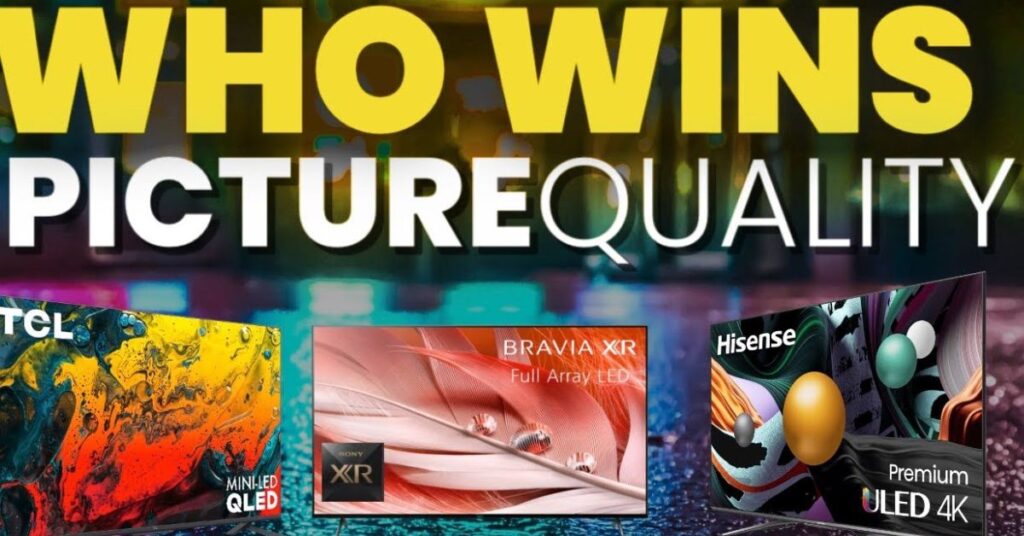The Hisense U8G is better for gaming compared to the Sony X90J, as it has a better contrast ratio, brighter display, and quicker response time. However, the Sony X90J offers superior out-of-the-box color accuracy, better build quality, and improved gradient handling.
In terms of differences between the two brands, Sony may have better low-quality content performance, motion handling, and quality control in manufacturing. On the other hand, Hisense excels in features like local dimming, brightness, and handling rooms with reflections.
Display Quality And Performance
The Hisense U8G offers superior display quality and performance compared to the Sony X90J, making it the better choice for gaming. With better contrast, blacks, color gamut, and brightness, the Hisense provides an immersive gaming experience. However, the Sony excels in out-of-the-box color accuracy, build quality and gradient handling.
Comparison Of Contrast Ratio, Black Levels, And Color Gamut
When it comes to display quality and performance, the Hisense U8G and the Sony X90J are two top contenders in the gaming TV market. Let’s dive deeper into how these TVs stack up against each other in terms of contrast ratio, black levels, and color gamut.
The Hisense U8G boasts a better contrast ratio compared to the Sony X90J. With its superior contrast ratio, the U8G is able to produce deeper blacks and more vibrant colors, creating a more immersive gaming experience. Additionally, the U8G offers a wider color gamut, ensuring that every hue and shade is accurately represented on the screen.
On the other hand, the Sony X90J shines in terms of out-of-the-box color accuracy and gradient handling. It delivers more accurate color reproduction right from the start, eliminating the need for manual adjustments. The X90J also excels in smoothly displaying gradients, ensuring that transitions between different shades are seamless and natural.
Evaluation Of Brightness Levels And Reflection Handling
Brightness levels play a crucial role in gaming, especially in dark or bright gaming environments. The Hisense U8G takes the lead in this aspect, as it offers higher brightness compared to the Sony X90J. This means that gaming visuals will appear more vivid, with details popping out even in well-lit rooms.
Moreover, the U8G outperforms the X90J in reflection handling. It effectively reduces the impact of ambient light reflections on the screen, allowing gamers to enjoy non-distracting visuals even in rooms with windows or other light sources.
Analysis Of Response Time And Motion Handling
For avid gamers, response time and motion handling are crucial factors that determine the smoothness and clarity of gameplay. The Hisense U8G impresses with its quick response time, minimizing motion blur and ghosting. This ensures that fast-paced action sequences are rendered sharply, enhancing overall gaming performance.
While the U8G excels in response time, the Sony X90J offers better motion handling and red ghosting control, resulting in smoother motion transitions. This means that on the X90J, there will be fewer artifacts and motion blur, providing a more immersive gaming experience.
In conclusion, both the Hisense U8G and the Sony X90J have their strengths and weaknesses in terms of display quality and performance for gaming. The U8G shines in contrast ratio, color gamut, brightness, and reflection handling, while the X90J stands out with its out-of-the-box color accuracy, gradient handling, and motion control. Ultimately, the choice between these two TVs will depend on your specific gaming preferences and priorities.

Color Accuracy And Gradient Handling
When it comes to gaming, color accuracy and gradient handling are important factors to consider. In this article, we will compare the Hisense U8G and Sony X90J in terms of their out-of-the-box color accuracy and gradient handling capabilities.
Discussion On The Out-of-the-box Color Accuracy Of Sony X90j
The Sony X90J is known for its exceptional out-of-the-box color accuracy. This means that right out of the box, the colors on the Sony X90J are more precise and true to life. With its advanced color calibration, the Sony X90J ensures that every hue and shade is rendered accurately, providing a visually satisfying experience for gamers.
Comparison Of Gradient Handling Capabilities Between The Two TVs
When it comes to handling gradients, both the Hisense U8G and Sony X90J have their strengths.
However, the Sony X90J takes the lead in gradient handling. It excels in smoothly transitioning between different shades and colors, leading to a more seamless and natural visual experience. Whether you’re playing action-packed games or watching high-resolution content, the Sony X90J delivers consistent and smooth gradients, enhancing overall picture quality.
The Hisense U8G, on the other hand, also offers decent gradient handling capabilities. While it might not match the level of precision and smoothness of the Sony X90J, it still provides satisfactory performance, especially considering its price point.
Overall, if color accuracy and gradient handling are crucial for you, the Sony X90J is the better choice. Its out-of-the-box color accuracy and superior gradient handling make it ideal for gamers who want the best visual experience possible. However, if you are on a budget and can compromise slightly on these aspects, the Hisense U8G still offers decent color accuracy and gradient handling capabilities.
Local Dimming And Brightness
When it comes to gaming, the quality of the TV’s local dimming and brightness are crucial factors to consider. In this comparison between the Hisense U8G and the Sony X90J, we will examine their performance in terms of local dimming technology and brightness levels in different room environments.
Explanation Of Hisense U8g’s Superior Local Dimming Technology
One of the standout features of the Hisense U8G is its superior local dimming technology. Local dimming allows the TV to adjust the backlight in specific areas of the screen, resulting in better contrast and deeper blacks. The U8G employs a full-array local dimming (FALD) system, which means it has a grid of LEDs behind the screen that can be controlled individually, providing precise control over the brightness levels. This technology enhances the overall picture quality and makes dark scenes appear more detailed and realistic.
Comparison Of Brightness Levels And Performance In Different Room Environments
When it comes to brightness, both the Hisense U8G and the Sony X90J have impressive capabilities, but they perform differently in various room environments. The U8G boasts a higher brightness level, allowing it to produce vivid and vibrant colors even in well-lit rooms. Its excellent brightness performance ensures that the gaming experience remains immersive, with no loss of detail or saturation.
On the other hand, the Sony X90J also offers good brightness levels, but it may not be as bright as the U8G in brighter room settings. However, the X90J compensates for this with its superior out-of-the-box color accuracy and excellent gradient handling. These qualities make it an appealing choice for gamers who prioritize color representation and smooth color transitions.
It is worth noting that the Hisense U8G performs exceptionally well in rooms with reflections. Its advanced local dimming technology helps to minimize the impact of reflections, allowing gamers to enjoy a distraction-free gaming experience. This is particularly beneficial for those who have their gaming setup in a well-lit room or near windows.
To summarize, both the Hisense U8G and the Sony X90J offer impressive local dimming and brightness capabilities. The U8G’s superior local dimming technology provides better contrast and deeper blacks, while its higher brightness levels result in a more immersive gaming experience, especially in well-lit rooms. On the other hand, the Sony X90J excels in out-of-the-box color accuracy and gradient handling, making it a suitable choice for gamers who prioritize color representation. Ultimately, the choice between the two depends on your specific preferences and gaming setup.
Other Considerations
When comparing the Hisense U8G and the Sony X90J for gaming, it’s essential to consider factors beyond just picture quality and gaming performance. Other aspects such as build quality and brand reliability play a crucial role in determining the overall value of a television.
Mention Of Sony’s Better Build Quality And Reliability In Manufacturing
One significant advantage of Sony televisions over Hisense is their exceptional build quality and reliability in manufacturing. Sony is known for its meticulous attention to detail and high-quality craftsmanship. The materials used in Sony TVs are durable and long-lasting, ensuring that your investment will stand the test of time. Their sturdy construction not only improves the overall aesthetics of the TV but also gives you peace of mind in terms of reliability.
Highlight Of Additional Positives Of Sony Compared To Hisense
In addition to its superior build quality, Sony offers several other positives compared to Hisense. These additional advantages further solidify Sony’s reputation as a top brand in the industry.
- Out-of-the-Box Color Accuracy: Sony TVs excel in delivering excellent color accuracy right out of the box. This means that you can enjoy vibrant and true-to-life colors without the need for extensive calibration or adjustments. Sony’s commitment to color precision ensures a visually pleasing gaming experience without any compromise.
- Better Gradient Handling: Another area where Sony surpasses Hisense is in gradient handling. Gradients are smooth transitions between different shades of color, and Sony TVs handle these transitions with impressive precision. This capability enables you to enjoy games with subtle color gradients, ensuring a more immersive gaming experience.
In summary, while Hisense may offer advantages in terms of contrast ratio, brightness, and reflection handling, it is essential to take into account Sony’s superior build quality and reliability in manufacturing. Sony also excels in out-of-the-box color accuracy and gradient handling, further enhancing the gaming experience. Consider all these factors when making your decision between the Hisense U8G and the Sony X90J.
Frequently Asked Questions Of Hisense U8g Vs Sony X90j| Which Is Better For Gaming
Is The Hisense U8g Good For Gaming?
Yes, the Hisense U8G is good for gaming. It has better contrast, blacks, color gamut, and brightness compared to other TVs. It also has a faster response time.
Is The Sony X90j Good For Gaming?
Yes, the Sony X90J is good for gaming as it has better out-of-the-box color accuracy, better build quality, and better gradient handling compared to the Hisense TV. However, the Hisense TV has better contrast ratio, brightness, and reflection handling, making it a strong competitor.
Is Sony Or Hisense Better?
Hisense is better than Sony in terms of contrast ratio, brightness, reflection handling, and response time. However, Sony has better color accuracy, build quality, and gradient handling. Hisense also performs better in low-quality content and rooms with reflections.
What Is The Difference Between Sony And Hisense?
Sony and Hisense have differences in their TV features. Hisense has better contrast ratio, brightness, reflection handling, and response time. On the other hand, Sony offers better out-of-the-box color accuracy, build quality, and gradient handling. Hisense excels in local dimming and brightness, while Sony may have better quality control and handles reflections well.
Both brands have their own strengths.
Conclusion
To sum up, both the Hisense U8G and Sony X90J have their respective strengths when it comes to gaming. The Hisense offers better contrast, blacks, color gamut, and brightness, making it a great choice for immersive gaming experiences. On the other hand, the Sony provides excellent out-of-the-box color accuracy, build quality, and gradient handling.
Ultimately, it comes down to personal preferences and priorities. So, weigh these factors carefully and choose the TV that aligns with your gaming needs and preferences.


